Posts Tagged ‘Australia’
-
THE MAGIC IS IN THE DETAIL
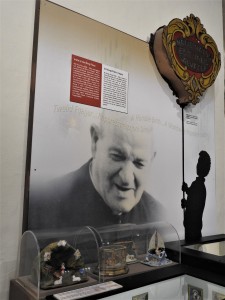 Although the main characters of the nativity scene are Joseph, Mary and baby Jesus, different cultures have added and altered the original representation in order to include their own characteristics. Some of these varying interpretations can be viewed in a permanent exhibition at the Inquisitor’s Palace in Birgu, which also houses the National Museum of Ethnography.
Although the main characters of the nativity scene are Joseph, Mary and baby Jesus, different cultures have added and altered the original representation in order to include their own characteristics. Some of these varying interpretations can be viewed in a permanent exhibition at the Inquisitor’s Palace in Birgu, which also houses the National Museum of Ethnography.In Malta, it was St George Preca (1880 – 1962) who fostered a lasting Christmas cult through his Society of Christian Doctrine. On Christmas Eve of 1921, he organized the first procession with a statue of baby Jesus. He also started the tradition of giving a crib and a statue of baby Jesus to every child who attended the MUSEUM centres.
In the exhibition, an image of Preca looks over at a rudimentary crib which has initiated a tradition that is still celebrated nowadays. A detailed diorama portrays further this tradition, showing a MUSEUM Superior handing out a crib to a boy, while a number of other children are already joyfully holding their cribs. An altar which is included in the diorama is decorated with flowing white vetch.
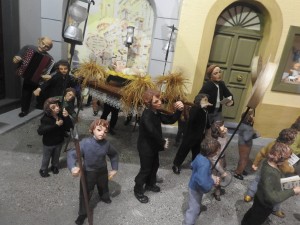 Another diorama looks like a time capsule showing the traditional procession of baby Jesus together with other local customs. Not only can one observe the MUSEUM members carrying the statue of baby Jesus, but one can also delight at the children carrying lights and Christmas messages while singing Christmas carols. The context is further enriched by the presence of traditional Maltese town houses, with their colourful wooden doors and with their wide open windows decorated with a small statue of baby Jesus.
Another diorama looks like a time capsule showing the traditional procession of baby Jesus together with other local customs. Not only can one observe the MUSEUM members carrying the statue of baby Jesus, but one can also delight at the children carrying lights and Christmas messages while singing Christmas carols. The context is further enriched by the presence of traditional Maltese town houses, with their colourful wooden doors and with their wide open windows decorated with a small statue of baby Jesus. These two dioramas form part of a set that was donated to Heritage Malta by Austin Galea; a well-established artisan and personality among local crib enthusiasts, and a founding member of the Għaqda Ħbieb tal-Presepju (Malta). The set of dioramas give life to further Christmas traditions, such as the sermon of the altar boy during Christmas’ eve mass, a large crib displayed for public viewing, a group of craftsmen in a workshop manufacturing statues and cribs, and a Christmas lunch being enjoyed by a family.
These two dioramas form part of a set that was donated to Heritage Malta by Austin Galea; a well-established artisan and personality among local crib enthusiasts, and a founding member of the Għaqda Ħbieb tal-Presepju (Malta). The set of dioramas give life to further Christmas traditions, such as the sermon of the altar boy during Christmas’ eve mass, a large crib displayed for public viewing, a group of craftsmen in a workshop manufacturing statues and cribs, and a Christmas lunch being enjoyed by a family.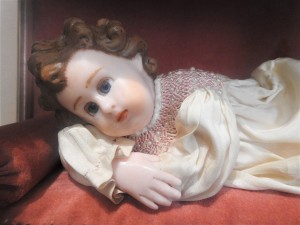 Galea has also donated two large nativity scenes which are typically exhibited in windows of private houses during the Christmas season in Malta. Other donations by him include different traditional statues of baby Jesus. Traditionally, the baby Jesus statues were made of wax to obtain a soft and translucent finish. The statues were eventually dressed up in an embroidered tunic, while many borrowed real hair from a toddler’s crowning curls.
Galea has also donated two large nativity scenes which are typically exhibited in windows of private houses during the Christmas season in Malta. Other donations by him include different traditional statues of baby Jesus. Traditionally, the baby Jesus statues were made of wax to obtain a soft and translucent finish. The statues were eventually dressed up in an embroidered tunic, while many borrowed real hair from a toddler’s crowning curls.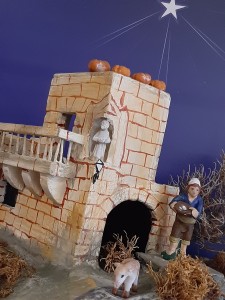 A large Maltese crib is also part of Galea’s generous donation. The crib is a comprehensive study of Maltese traditions in itself. Typical Maltese figurines are dressed in traditional local costumes, and among them, one also finds the unique Maltese symbolic characters. The Stupefied figurine represents those who are impressed by the profound meaning of the unique happening. The Beggar represents the poor who find consolation in Christ. The Climber represents those who find it difficult to understand the significance of Christ’s incarnation but strive to discover out. The Folk Singers represent communal association in praising the Lord, while the Sleeper represents those who ignore the immeasurable benevolence of Christ. The rugged landscape with its terraced fields, sparse vegetation, low-profile unpretentious farmhouses and a windmill are reminiscent of the rural ambience of the old times.
A large Maltese crib is also part of Galea’s generous donation. The crib is a comprehensive study of Maltese traditions in itself. Typical Maltese figurines are dressed in traditional local costumes, and among them, one also finds the unique Maltese symbolic characters. The Stupefied figurine represents those who are impressed by the profound meaning of the unique happening. The Beggar represents the poor who find consolation in Christ. The Climber represents those who find it difficult to understand the significance of Christ’s incarnation but strive to discover out. The Folk Singers represent communal association in praising the Lord, while the Sleeper represents those who ignore the immeasurable benevolence of Christ. The rugged landscape with its terraced fields, sparse vegetation, low-profile unpretentious farmhouses and a windmill are reminiscent of the rural ambience of the old times.Besides donating his first clay crib figurines which were given to him by his aunties and an unusual crib made of sacks that was constructed by him, Galea shares also his knowledge relating to Christmas crib construction in a short video which forms part of this exhibition.
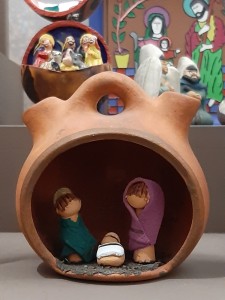 Another intriguing element in this exhibition is the donation of numerous miniature cribs which were brought by Albert and Lina McCarthy from all over the world. The professional tour managers have been gathering this impressive collection since the early 90s. Their collection amounts to more than 500 miniature works of art, a representative selection of which is on display at the Inquisitor’s Palace.
Another intriguing element in this exhibition is the donation of numerous miniature cribs which were brought by Albert and Lina McCarthy from all over the world. The professional tour managers have been gathering this impressive collection since the early 90s. Their collection amounts to more than 500 miniature works of art, a representative selection of which is on display at the Inquisitor’s Palace.Exhibited in four different sections, the varying nativity scenes representing North and East Europe, Southern Europe and the Near East, North and South America, and Africa, Asia, the Far East and Australia are simply enchanting. The magic is in the detail of each crib which presents the nativity scene in various contexts, with distinct characters and in diverse materials.
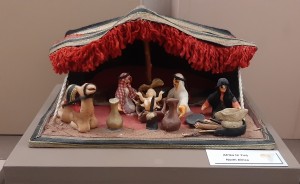 Some of the most notable are the terracotta nativity sets from Hungary and Peru, the ceramic sets from Denmark and the Philippines, the engraved wooden shoe from Amsterdam, the wooden sets of Germany, Austria, Japan and Iran, the metallic artwork from Bali, the sack nativity set from Sri Lanka and the clay figurines of North Africa set in a bedouin tent, dressed in traditional costumes and accompanied by a camel instead of farm animals.
Some of the most notable are the terracotta nativity sets from Hungary and Peru, the ceramic sets from Denmark and the Philippines, the engraved wooden shoe from Amsterdam, the wooden sets of Germany, Austria, Japan and Iran, the metallic artwork from Bali, the sack nativity set from Sri Lanka and the clay figurines of North Africa set in a bedouin tent, dressed in traditional costumes and accompanied by a camel instead of farm animals.A visit to this permanent exhibition held at the Inquisitor’s Palace is most educational and entertaining for children, and also curious and insightful for adults. The exhibits are a tribute to local and foreign artisans who have used their creativity to reproduce the significant nativity scenes in various intriguing representations.
(Published in Christmas Times magazine issue with The Times of Malta dated 7th December 2019)
-
Long shell life
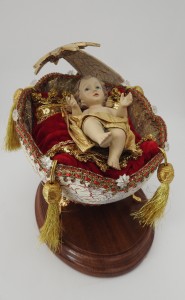 Although during the Christmas season, it is customary to see statues of baby Jesus in a manger or in a crib, in Candice Fava’s shop New EGGsperience, the holy child would be seen resting in a decorated eggshell.
Although during the Christmas season, it is customary to see statues of baby Jesus in a manger or in a crib, in Candice Fava’s shop New EGGsperience, the holy child would be seen resting in a decorated eggshell.“I love to create unique hand-made objects and this craft of eggshell decoration has provided me with the opportunity to have my own niche market,” Fava explains.
Fava was raised on a farm in Australia, where her family sold eggs. They had several clients but one particular client intrigued Fava since she regularly purchased a substantial quantity of eggs.
“One day I decided to ask her why she always needed so many eggs and she promised that the next time she called at our farm, she would bring me a gift to show me. I felt deeply curious and I awaited her next visit with much anticipation. Eventually, she brought me a little jewel box adorned with lovely fabrics and accessories. I could not believe that she had actually made it with one of the eggs from our farm!”
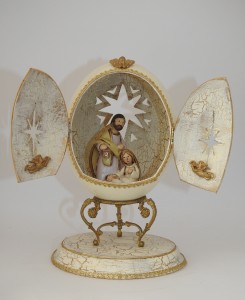 Fava was so fascinated with this idea that she decided to learn this craft. At the farm, she had all the eggs that she required and in time she learnt how to clean them without breaking them. Soon, she was producing her own eggshell decorations.
Fava was so fascinated with this idea that she decided to learn this craft. At the farm, she had all the eggs that she required and in time she learnt how to clean them without breaking them. Soon, she was producing her own eggshell decorations.“The first item I made was a jewel box which I painted with bright nail polish. I was so delighted when I saw it ready! Today I realize that it wasn’t much but it is still very dear to me as it reminds me from where it all started.”
Along the years, eggshell decoration became an integral part of Fava’s life. Which explains why she was surprised when she came over to Malta and realized that this craft was totally unknown on the island.
“It was hard at first to find the necessary materials to work with. However, my husband Ivan helped me to locate some local farms which could provide me with eggs. He also assisted me in the cleaning and sterilization of the eggshells.”
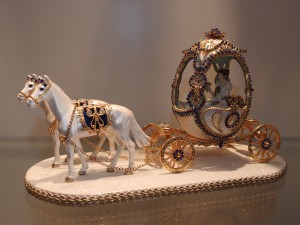 Initially she decorated eggshells for her personal enjoyment. Then she began to give them out as gifts to her friends.
Initially she decorated eggshells for her personal enjoyment. Then she began to give them out as gifts to her friends.“My friends were delighted with these eggshell decorations since they had never seen anything like them before. Soon they were asking me to make some more creations for them so that they could give them as presents to others. It was only a matter of time until I confirmed that there was a demand for such products.”
Ultimately, people’s positive reactions to her craft led her to open her own shop in Zabbar.
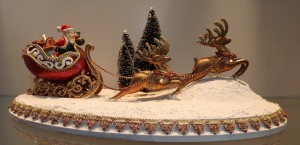 “By then, I had produced so many various eggshell decorations that I had no difficulty to fill the shop with my creations. Each time that new clients come in, it is charming to see their incredulity that so many exquisite things can be made from common fragile eggshells.”
“By then, I had produced so many various eggshell decorations that I had no difficulty to fill the shop with my creations. Each time that new clients come in, it is charming to see their incredulity that so many exquisite things can be made from common fragile eggshells.”Nowadays, the Favas have located foreign suppliers who are able to furnish them with quantities of ready-made cleaned and sterilized eggshells. Moreover, they have also managed to establish contacts with suppliers of other materials with which the eggshells are decorated.
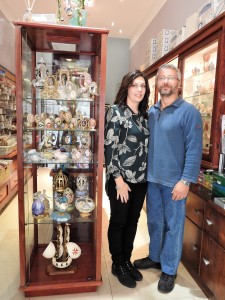 “My husband supports me a lot and helps me to come out with new ideas. Along the years, he too became enthusiastic about this work and now he is able to make his own creations.”
“My husband supports me a lot and helps me to come out with new ideas. Along the years, he too became enthusiastic about this work and now he is able to make his own creations.”A wide range of differently decorated eggshells which are ideal as gifts for various occasions are displayed at their shop. However, a few of them are not for sale.
“When we join forces, we create the best decorations,” the two agree. “The collaboration of ideas lead to exclusive objects which become difficult to part from. Some of them, such as the lamp shade, the handbag set and the sea vessel, are cherished objects and we have won prestigious awards for them at local national craft competitions. Such works provide us also with the opportunity to combine different materials and crafts like woodwork and eggshell decoration. Our imagination has no limit, however we are restrained with the eggshells’ curvatures, although we take that as part of the challenge.”
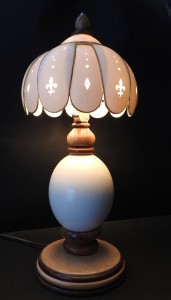 Even though all of the creations may serve as decorations, some of them also have their own practical use, acting as exotic containers, wearable accessories or light fittings.
Even though all of the creations may serve as decorations, some of them also have their own practical use, acting as exotic containers, wearable accessories or light fittings.“Besides selling our creations from my shop, I also participate in several fairs and exhibitions and therefore more people are getting to know about this craft. Presently I am also taking part in the program Niskata which airs on TVM. Yet there is still much more to do to create more awareness.”
“It is great to see how far a simple hobby can take you. Little by little, all my family has become involved in this craft. In fact, my daughter is already coming up with her own designs and creations and my little son is showing interest too.”
In these last years, Fava has also dedicated herself to teach this craft to all those who are interested, both children and adults. She has also furnished her shop with all the necessary materials including eggshells of various sizes, cut eggshells, acrylic paints, stands, bases and a multitude of other items.
As Christmas time approaches, the two explore the possibility of new designs and ideas in order to come out with original creations which relate to this theme.
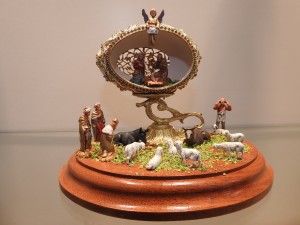 “We are always dreaming of what we are going to do next. We work with all sorts of eggshells, starting with the smallest ones of love-birds and parrots, and moving on to larger ones such as those of pigeons, quails, ducks, geese, emu, rhea and ostrich. The geese’s eggs are the most practical because of their size and shape. Other eggs are relished for their natural particular characteristics such as the blackish colour of the rhea eggs and the large shape and pearly shade of the ostrich eggs.”
“We are always dreaming of what we are going to do next. We work with all sorts of eggshells, starting with the smallest ones of love-birds and parrots, and moving on to larger ones such as those of pigeons, quails, ducks, geese, emu, rhea and ostrich. The geese’s eggs are the most practical because of their size and shape. Other eggs are relished for their natural particular characteristics such as the blackish colour of the rhea eggs and the large shape and pearly shade of the ostrich eggs.”“Christmas brings a lot of joy and memories. This festive season opens up a whole new world to create related items with baby Jesus statues, cribs, angels, Father Christmas, reindeers, sparkles and a whole range of bright colours. We love to reflect the warm meaning of Christmas in our works.”
-
Take me to church
“ ‘They have hit our church!’ cried a man as he stumbled down in the tunnel which was located under the Mall Garden. We were huddling in there for shelter together with many other people as the bombs came down over Floriana,” reminisced Pawlu Piscopo who was eight at the time.
 “At this horrible news, my father grabbed me and my brother by the hand and took us out of the tunnel and over to the granaries where a very sad spectacle awaited us. St Publius’ Church had suffered a direct hit. Its dome was gone and the area was surrounded in rubble. Thirteen people who were taking cover in the church’s crypt were killed and eleven more were injured. That was the blackest moment in the history of the parish church of Floriana: April 28, 1942 at 7:50am.”
“At this horrible news, my father grabbed me and my brother by the hand and took us out of the tunnel and over to the granaries where a very sad spectacle awaited us. St Publius’ Church had suffered a direct hit. Its dome was gone and the area was surrounded in rubble. Thirteen people who were taking cover in the church’s crypt were killed and eleven more were injured. That was the blackest moment in the history of the parish church of Floriana: April 28, 1942 at 7:50am.”After their house had been bombed, Pawlu’s family were allowed to take some respite in a large residence which today houses the Floriana Local Council. Yet for four years, they lived mostly underground in this tunnel which probably saved their lives. They took with them only a few belongings and the most cherished items, including a statue of St Publius which dated back to 1928 and used to adorn the model altar that his father had constructed at home.
“Most families in Malta had a model of an altar or a miniature church at home at the time. Unfortunately, many of these had to be abandoned during the war and a good number of them were destroyed when the houses were bombed.”
The craft of church model-making had been introduced to our islands by the Knights of St John back in the 16th century, and therefore its knowledge was a distinct tradition. However the adversity of war ravaged even this precious memory until eventually this craft was almost completely forgotten.
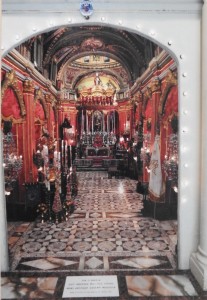 “After the war, people tried to get on with their lives as best as they could. Shops started to open again but those that used to sell miniature items with which to decorate our religious models, dwindled down to almost none. Nevertheless, the passion for model-making was much engrained in our family and when I bought a miniature structure made of four columns and a dome from a man who was leaving Malta to go to live in Australia, my father Carmelo was inspired to use it as the foundation for a model of St Publius’ church,” explained Pawlu.
“After the war, people tried to get on with their lives as best as they could. Shops started to open again but those that used to sell miniature items with which to decorate our religious models, dwindled down to almost none. Nevertheless, the passion for model-making was much engrained in our family and when I bought a miniature structure made of four columns and a dome from a man who was leaving Malta to go to live in Australia, my father Carmelo was inspired to use it as the foundation for a model of St Publius’ church,” explained Pawlu.Carmelo was a very skilled carpenter. He would go from time to time to have a look at the church and then go back to his model and construct an exact copy of the section that he had seen.
“He used the material which was handy at the time, mostly cardboard, wood and gypsum. I helped him out too in order to build the whole church which included ten altars. Eventually, this model reached a huge size of three by four metres and we could walk in it and look above at the beautiful dome,” Pawlu said proudly.
Once his father grew old, Pawlu continued with the work on this church which they had started back in the early 1960s. As he embellished this model, the wish to set up a group for model-makers in order to share this passion with them, burnt within him.
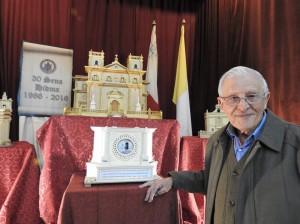 “On February 26, 1986 which happenned to be the tenth anniversary of my father’s demise, I discussed this idea with two of my friends, Raphael Micallef and Tony Terribile, who were very interested in this sector. We all agreed to do something in order to revive this craft and we sent out adverts in the newspapers to announce the set up of this group which we called Għaqda Dilettanti Mudelli ta’ Knejjes (Church Modelling Society). We were very happy when we received a great response from enthusiastic individuals all over Malta. Soon, a commitee was formed and on March 1986, we organized the first exhibition during the first two weeks of Lent wherein the members displayed the works that they had.”
“On February 26, 1986 which happenned to be the tenth anniversary of my father’s demise, I discussed this idea with two of my friends, Raphael Micallef and Tony Terribile, who were very interested in this sector. We all agreed to do something in order to revive this craft and we sent out adverts in the newspapers to announce the set up of this group which we called Għaqda Dilettanti Mudelli ta’ Knejjes (Church Modelling Society). We were very happy when we received a great response from enthusiastic individuals all over Malta. Soon, a commitee was formed and on March 1986, we organized the first exhibition during the first two weeks of Lent wherein the members displayed the works that they had.”It was certainly a great satisfaction to see this society thrive and grow along the years, always adding up new members of various ages. Today, around 400 members form part of this group which operates from its premises at 37, East Street, Valletta.
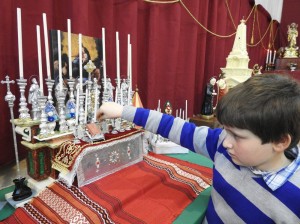 “This year we are delighted to celebrate the 30th anniversary from the establishment of this society,” Pawlu said. “The annual exhibition has been taking place each year. Besides offering the opportunity to showcase our members’ works, this event has served to help our members and the public which visits it, to meditate during the Lent period and to prepare for the Easter celebrations.”
“This year we are delighted to celebrate the 30th anniversary from the establishment of this society,” Pawlu said. “The annual exhibition has been taking place each year. Besides offering the opportunity to showcase our members’ works, this event has served to help our members and the public which visits it, to meditate during the Lent period and to prepare for the Easter celebrations.”A bi-monthly magazine, Il-Knisja Tiegħi (My Church), which was also initiated by Pawlu, is marking its 30th anniversary too. Members have been writing features in it related to different aspects of religious folklore, thereby kindling even further interest in model-making.
Once again this year, the society has organized this exhibition which saw the participation of several of its members. Exhibits varied and included small to large statues of the passion of Christ and Easter, statues of Blessed Mary and several saints, models of altars, church facades and whole churches made of different materials.
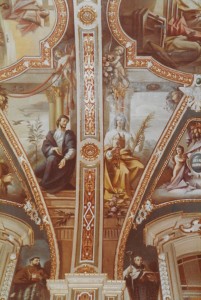 “I hope that I’ll have enough strength to exhibit my large model of St Publius’ church,” revealed Pawlu at one point. “It takes me four weeks to set it up on a large platform and to connect the miniature chandeliers and light fittings to electricity. I am getting old now and such work is very tiring.”
“I hope that I’ll have enough strength to exhibit my large model of St Publius’ church,” revealed Pawlu at one point. “It takes me four weeks to set it up on a large platform and to connect the miniature chandeliers and light fittings to electricity. I am getting old now and such work is very tiring.”Pawlu has been exhibiting this model in a building besides the Floriana Cathecism Museum for many years now, during the feast of St Publius which takes place two weeks after Easter.
“Many people come to visit my model and they are fascinated with it. Tourists take photos besides it and they ask me how I managed to construct it section by section and yet making it look as a whole. I tell them that there are lifetimes of passion invested within it and that it is imbued with a blend of religious meaning and local traditional skills and creativity.”
At 82 years, Pawlu is serene and thankful to see the society which he has founded together with his friends strengthen itself and adding members to it.
“I just wish that it will continue to flourish for very long,” smiled Pawlu as he looked contentedly around him in order to appreciate the beautiful displayed works of the society’s members.
(This article was published in the Easter Supplement which was issued with The Times of Malta dated 21st March 2016)
-
AROUND THE WORLD IN 90 DAYS
“They say that you always travel three times: the first time when you are planning your holiday,then when you actually travel, and finally when you watch the photos that you have taken whilst travelling,” Jennifer told me as she proudly showed me the pictures that she and her husband Alan took during their three month honeymoon trip around the globe.
Since Alan Borg and Jennifer Cusba got to know each other, their life turned into an adventure. They met incidentally on a boat trip whilst they were visiting the enchanting lakeside town of Guatapé in Colombia.
 “I was on holiday in Colombia with my friends, when we decided to go on this particular boat trip. At one point, I saw Jennifer walking by with her mother and I liked her immediately. So I followed her, waiting for an excuse to talk to her. The right moment came when I noticed that she needed someone to take their photo and I offered to help. Then, I made sure to take a photo with her too,” revealed Alan.
“I was on holiday in Colombia with my friends, when we decided to go on this particular boat trip. At one point, I saw Jennifer walking by with her mother and I liked her immediately. So I followed her, waiting for an excuse to talk to her. The right moment came when I noticed that she needed someone to take their photo and I offered to help. Then, I made sure to take a photo with her too,” revealed Alan.For the following three months, they kept in contact through Facebook. During one of their communications, Jennifer who is Colombian, told Alan that she was planning to go to America to study English.
“I lived in Bogotá, the capital city of Colombia, where I worked as an internal auditor of a governmental company. I had studied hard to obtain this job and in the first years, I was very satisfied that I had succeeded in this career. However, as time went by, I felt that life had become stale. I woke early each day to travel for two hours to reach work, meeting always the same people on the bus and at work, and likewise on my two hour ride back home. At 29 years, I felt as if I was stuck in a rut and I was afraid that if I continued to live this mundane life, I would lose all the essence of life. I definitely had to do something to make a change,” reminisced Jennifer.
Once again, Alan did not fail to grab the opportunity, and as soon as he learnt that Jennifer wanted to study English, he informed her about the selection of English schools that there were in Malta. Attracted by Alan’s gentle and friendly attitude, and also by the fact that it was cheaper to study in Malta than in America, Jennifer chose the small archipelago of the Maltese Islands. Once in Malta, their friendship grew stronger, she gave up her job in Colombia, and a year later, they got married.
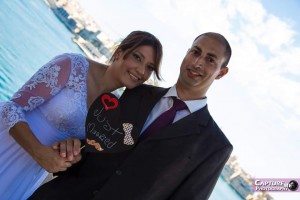 “When we told our friends and relatives that we were going to get married, they all wanted to know when and where the wedding is going to take place and how many guests would be invited. However, we had no intention of spending thousands of euros for just a few hours of enjoyment. Our plans were much bigger!” claimed Alan.
“When we told our friends and relatives that we were going to get married, they all wanted to know when and where the wedding is going to take place and how many guests would be invited. However, we had no intention of spending thousands of euros for just a few hours of enjoyment. Our plans were much bigger!” claimed Alan.“On our wedding day we were joined by our family and closest friends. After the celebration, we shared a cake, drank some champagne, took photos, had a lot of fun, and that was that. The big moment came seven months later, when we prepared our backpacks and left for the adventure of a lifetime,” continued Jennifer.
Alan decided to make the best of the various offers and discounts that his job with an airline company afforded him. The couple started out with an initial idea of a simple honeymoon to Santorini, fully aware that they’d need to get a connecting flight from another location. Soon, this stopover was joined by other countries until the list grew and grew. Eventually, they decided to go on a three month trip around the world, to the total tune of 15,000 euros.
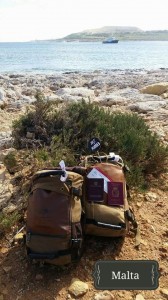 “We both love to travel. Yet I was the one who was more experienced in travelling to faraway countries without concerning myself too much on a fixed itinerary. In fact, at first, Jennifer was somehow incredulous whether this voyage would take place for real,” smiled Alan.
“We both love to travel. Yet I was the one who was more experienced in travelling to faraway countries without concerning myself too much on a fixed itinerary. In fact, at first, Jennifer was somehow incredulous whether this voyage would take place for real,” smiled Alan.“It’s true! I was worried whether we would have enough money to do it all and what would happen if we spent everything whilst still abroad? I was also afraid that someone could steal our cards or that unknowingly, we could end up in some dangerous country or get caught up in a terrorist attack.”
In reality, during this amazing voyage, the couple did have their fare share of risk… In New York, they experienced a huge storm and they could not get out of their hotel room. In Colombia, whilst they were seeing a horseshow, an earthquake shook the building which they were in. In Australia, just a week after they left, the Central Coast was a complete disaster with houses being carried away due to heavy floods and strong winds.
“Before we left on our adventure, I left a simple message on Facebook saying that we were going on our honeymoon, never mentioning that we were going for a trip around the world, because I couldn’t believe it myself! Off we went to Amsterdam and then we started to move and move and move, until I realized that this dream was becoming true. It became very very real whilst we were on the long flight crossing from Australia to Japan, and I started to note the various countries showing on the screen in front of me. By then, we had been to many of them, changing even continents, and there it dawned on me that we were truly going around the world,” Jennifer exclaimed.
 Although they had planned an overall general itinerary of the places and sites which they wished to visit, they prebooked nothing except their first destination to Amsterdam. And yet, they managed to see and do many many things. Their travels took them to Amsterdam, New York, Las Vegas, Arizona, San Francisco, Mexico, Brazil, Colombia, Peru, Chile, Sydney, New South Wales, Melbourne, Queensland, Japan, and Istanbul.
Although they had planned an overall general itinerary of the places and sites which they wished to visit, they prebooked nothing except their first destination to Amsterdam. And yet, they managed to see and do many many things. Their travels took them to Amsterdam, New York, Las Vegas, Arizona, San Francisco, Mexico, Brazil, Colombia, Peru, Chile, Sydney, New South Wales, Melbourne, Queensland, Japan, and Istanbul.“Ultimately, this was not just a holiday but an experience. Certainly, quite a great way to start a new and exciting chapter as husband and wife,” beamed Alan as he winked at Jennifer.
(This article was published in ‘Escape’ cultural suppliment issued with the Sunday Times of Malta dated 4 October 2015)
-
CHRISTMAS EGGS
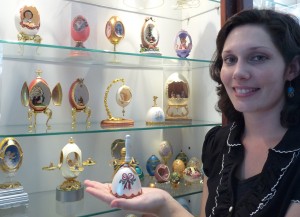 Natives watched eagerly with awe as the foreign traders unwrapped large ostrich eggs decorated with exotic painted designs. The Phoenician merchants were sure that the ornamented eggs will be sold out in a matter of minutes, for this race possessed the key to humanity’s heart – the ability to manipulate a sense of wonder. Centuries later this magic still lives … an ingenious craft which started far away in an Australian farm has recently been introduced to our islands by Candice Fava, whose artistry in egg decoration is a joy to behold.
Natives watched eagerly with awe as the foreign traders unwrapped large ostrich eggs decorated with exotic painted designs. The Phoenician merchants were sure that the ornamented eggs will be sold out in a matter of minutes, for this race possessed the key to humanity’s heart – the ability to manipulate a sense of wonder. Centuries later this magic still lives … an ingenious craft which started far away in an Australian farm has recently been introduced to our islands by Candice Fava, whose artistry in egg decoration is a joy to behold.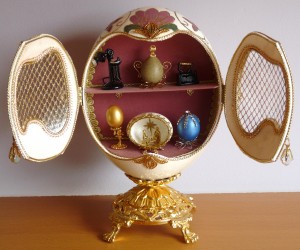 “I have fond memories of my childhood. My family lived in a farm in Australia from which we used to sell eggs. We had lots of clients but one particular client attracted my attention since she regularly purchased a substantial quantity of eggs. One day I decided to ask her why she always needed so many eggs and she promised that the next time she called at our farm, she will bring me a gift to show me. I felt deeply curious and I awaited her next visit with much anticipation. When she came she brought me a little jewel box adorned with lovely fabrics and accessories. I could not believe that she had actually made it with one of the eggs from our farm! It was such a fascinating idea that I made up my mind to learn this craft. I was blessed to have so much eggs to experiment upon and my mum urged me and gave me ideas to be creative. Eventually I succeeded to learn how to empty the eggs and clean them thoroughly without breaking them. The first item I made was a jewel box which I painted with a bright nail polish. I was so delighted when I saw it ready! Today I realize that it wasn’t much and I keep it hidden away. However it is very dear to me as it reminds me from where it all started.”
“I have fond memories of my childhood. My family lived in a farm in Australia from which we used to sell eggs. We had lots of clients but one particular client attracted my attention since she regularly purchased a substantial quantity of eggs. One day I decided to ask her why she always needed so many eggs and she promised that the next time she called at our farm, she will bring me a gift to show me. I felt deeply curious and I awaited her next visit with much anticipation. When she came she brought me a little jewel box adorned with lovely fabrics and accessories. I could not believe that she had actually made it with one of the eggs from our farm! It was such a fascinating idea that I made up my mind to learn this craft. I was blessed to have so much eggs to experiment upon and my mum urged me and gave me ideas to be creative. Eventually I succeeded to learn how to empty the eggs and clean them thoroughly without breaking them. The first item I made was a jewel box which I painted with a bright nail polish. I was so delighted when I saw it ready! Today I realize that it wasn’t much and I keep it hidden away. However it is very dear to me as it reminds me from where it all started.”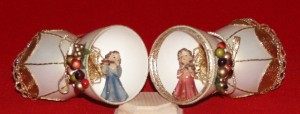 Looking at the variety of decorated eggs in her shop NewEggsperience in Żabbar, it was clear that Candice had learned the craft quite well. I surely found it hard to understand how she could carve out doors, windows, shelves and other designs from a simple egg-shell. And like the famous incredulous St Thomas, she had to allow me to hold an object in my hands in order to affirm that it was really made out of an egg.
Looking at the variety of decorated eggs in her shop NewEggsperience in Żabbar, it was clear that Candice had learned the craft quite well. I surely found it hard to understand how she could carve out doors, windows, shelves and other designs from a simple egg-shell. And like the famous incredulous St Thomas, she had to allow me to hold an object in my hands in order to affirm that it was really made out of an egg.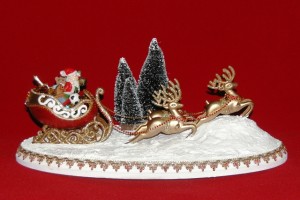 “People everywhere react in this way with regards to these items since most think that eggshell is too fragile to work with. However the eggs which I use today are provided by foreign farms who specialize in this sector where probably the birds are given food mixed with fragmented shells in order to harden the quality of their eggshells. This craft is so widespread in different countries that there are also factories which sell a variety of cleansed eggs.”
“People everywhere react in this way with regards to these items since most think that eggshell is too fragile to work with. However the eggs which I use today are provided by foreign farms who specialize in this sector where probably the birds are given food mixed with fragmented shells in order to harden the quality of their eggshells. This craft is so widespread in different countries that there are also factories which sell a variety of cleansed eggs.”Yet when Candice came over to Malta, she was quite shocked as there were no shops who sold the accessories needed for this work.
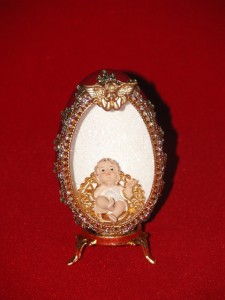 “This craft was totally unknown in Malta but with the help of my husband I searched on the internet and I succeeded to buy all that was necessary online. Egg decoration had become an essential part of my life and I simply could not stop creating new things. Initially I did these objects for my personal satisfaction. Then surprisingly, when I started to give them out as gifts, I began to receive requests from my friends to make something for them. Eventually I had so many finished objects and I saw so much interest in my work, that I decided to fulfill another dream of mine and I opened this shop.”
“This craft was totally unknown in Malta but with the help of my husband I searched on the internet and I succeeded to buy all that was necessary online. Egg decoration had become an essential part of my life and I simply could not stop creating new things. Initially I did these objects for my personal satisfaction. Then surprisingly, when I started to give them out as gifts, I began to receive requests from my friends to make something for them. Eventually I had so many finished objects and I saw so much interest in my work, that I decided to fulfill another dream of mine and I opened this shop.”A range of eggs of various sizes and colours were ready to be transformed into new creations. Likewise, small jars of colourful paint and a multitude of various decorations were crying out to become part of a new charming object.
“I’m always dreaming of what I can do next. I work with all sorts of eggs, starting with the smallest ones of love-birds and parrots, and moving on to larger ones such as those of pigeons, quails, ducks, geese, emu, rhea and ostrich. The geese’ eggs are the most practical because of their size and shape. Other eggs are relished for their natural particular characteristics such as the blackish colour of the rhea eggs and the large shape and pearly shade of the ostrich eggs.”
For the Christmas season, Candice has come up with exquisite original creations.
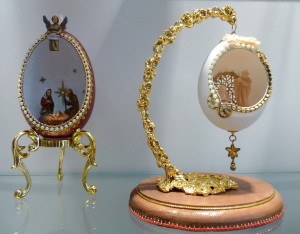 “Christmas time is wonderful and I love to reflect its warm sensations and meaning in my works. Cribs are the most requested although I have a vast selection of other items too. I’m constantly pondering over new creations as I thrive hard to provide unique hand-made objects which one could give to that special person who deserves such an exclusive gift.
“Christmas time is wonderful and I love to reflect its warm sensations and meaning in my works. Cribs are the most requested although I have a vast selection of other items too. I’m constantly pondering over new creations as I thrive hard to provide unique hand-made objects which one could give to that special person who deserves such an exclusive gift.Some clients have even asked me to show them how these creations are done in order to be able to produce them for themselves and also to compose their very own personal gift this Christmas. I instructed them how to do Christmas crackers first and many clients were delighted to see that even they could produce beautiful objects. For after all, it’s all a matter of creativity, dedication and much patience.”
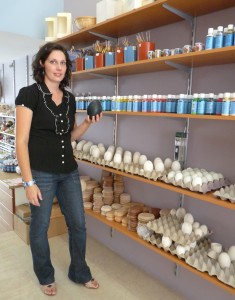 I asked her whether she was worried that these very clients would one day become her very competitors.
I asked her whether she was worried that these very clients would one day become her very competitors.“Probably some of them might but I have no problem with that. Instead I feel great satisfaction when I understand that I succeeded to initiate the love for this craft in these islands. For after all what is the value of such creativity if you can’t share it with others?”
(Note: An edited version of this article was published in FIRST Issue December 2011)
Travelogue
Archives
| M | T | W | T | F | S | S |
|---|---|---|---|---|---|---|
| « Jan | ||||||
| 1 | 2 | 3 | 4 | 5 | 6 | 7 |
| 8 | 9 | 10 | 11 | 12 | 13 | 14 |
| 15 | 16 | 17 | 18 | 19 | 20 | 21 |
| 22 | 23 | 24 | 25 | 26 | 27 | 28 |
| 29 | 30 | 31 | ||||
Recent Posts
- A MATTER OF FATE
- MALTA’S PREHISTORIC TREASURES
- THE MAGIC IS IN THE DETAIL
- THE SELLING GAME
- NEVER FORGOTTEN
- Ġrajjiet mhux mitmuma – 35 sena mit-Traġedja tal-Patrol Boat C23
- AN UNEXPECTED VISIT
- THE SISTERS OF THE CRIB
Comments
- Pauline Harkins on Novella – Li kieku stajt!
- admin on IL-KARNIVAL TRAĠIKU TAL-1823
- Albert on IL-KARNIVAL TRAĠIKU TAL-1823
- Martin Ratcliffe on Love in the time of war
- admin on 24 SENA ILU: IT-TRAĠEDJA TAL-PATROL BOAT C23